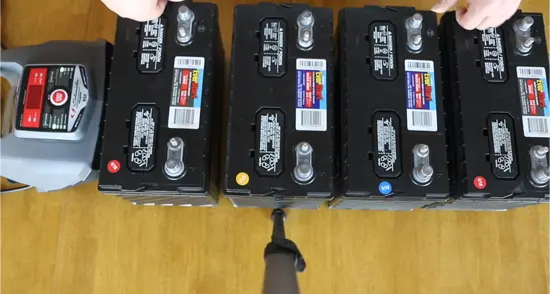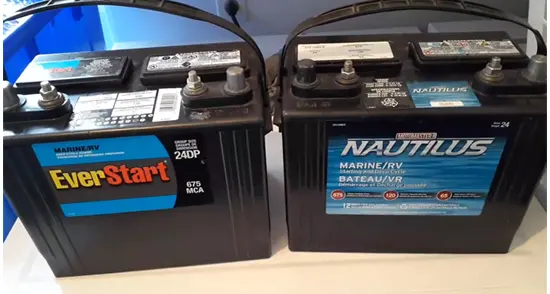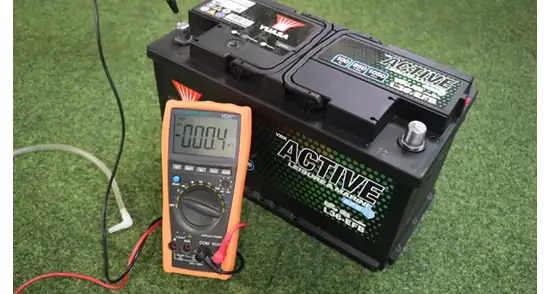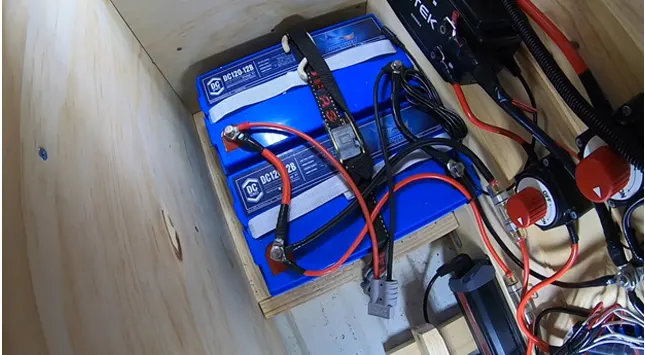Last Updated on April 11, 2023
As you charge your RV’s deep cycle battery, you may notice that it makes a slight bubbling noise. Should deep cycle batteries bubble? You should know if this bubbling is normal or if it indicates a problem.
Deep cycle batteries are different from standard automotive batteries. They are made to be discharged and recharged many times, so they’re often used in RVs, solar energy systems, and golf carts.
Considering the fact that there are different types of deep cycle batteries, the answer to whether or not they bubble will depend upon the type of battery you have. Now let’s break it down.
Should Deep Cycle Batteries Bubble? Discover the Answer

In order to determine whether the bubbling noise is normal for your deep cycle battery, you will need to identify its type. Deep cycle batteries are available in many different varieties, each with its own specific characteristics. We will explore a few of the most common types and answer the questions regarding each.
1. Lead-Acid Battery
If you have a lead acid battery, it is normal for it to bubble when charging. These types of batteries contain plates made of lead and separated by a porous separator. The battery plates are dipped in an electrolyte solution of water and sulfuric acid.
When the lead acid batteries are being charged, the distilled water in the electrolyte solution begins to degrade. During this decomposition, hydrogen gas is produced, which collects around the positive plates.
Eventually, enough hydrogen gas builds up to form bubbles. These bubbles help to increase the surface area of the positive plate, which makes it easier for electrons to flow between the plate and the electrolyte solution.
Due to this, lead-acid batteries are capable of charging more quickly and efficiently. As a matter of fact, lead-acid batteries come in different varieties, and not all of them bubble while charging.
To know for sure, you need to identify which type you possess. Listed below are the most common types of lead-acid batteries and whether they should bubble during charging.
- Gel Cell Battery
Due to the fact that this is a type of lead-acid flooded battery, it does not bubble during charging. These RV or golf cart batteries use gel instead of the traditional electrolyte solution. The gel is made up of sulphuric battery acid and silica, which gives it a gelatinous consistency.
Compared to liquid electrolyte batteries, these are less likely to spill, and they can also handle a wider range of temperatures. During charging the gel batteries, the sulphuric acid in the gel reacts with the lead plates to create lead sulfate.
Through the action of the charged electrons, the lead sulfate is converted back into lead and sulphuric acid. It keeps going until the battery is full. There is no decomposition of water during this process, and therefore there is no production of hydrogen gas. As a consequence, gel cell batteries do not bubble during charging.
- AGM Battery
When being charged, AGM batteries will not bubble since they do not use a liquid electrolyte solution. Instead, the electrolyte is absorbed onto glass mats that are situated between the lead plates.
AGM batteries do not release hydrogen gas when they are charged, so there is no bubbling or gassing that occurs. When the electrolyte in the electrodes is charged, sulphuric acid reacts with the plates to form lead sulfate.
Lead sulfate and sulfuric acid are converted back into lead and sulfur after the electrons are charged. The process continues for the battery to charge.
- VRLA Battery
VRLA batteries are valve-regulated lead-acid batteries that use recombinant technology to reduce gassing. During charging, the recombination of the oxygen and hydrogen produced inside the battery produces heat. This heat, in turn, causes the electrolyte water to vaporize, producing bubbles.
The bubbles rise to the surface of the electrolyte and eventually burst, releasing their contents back into the liquid. This process helps to keep the VRLA battery from overheating and degrading the internal components. Also, it prevents the emissions of hazardous gasses from the VRLA battery when it is charged and discharged.
2. Lithium Battery
While it is normal for your RV lithium-ion deep cycle batteries to heat up during charging, it is not normal for them to bubble. If your battery starts bubbling, it is an indication that something is wrong, and you should stop charging immediately.
Lithium-ion batteries use a different charging process than lead-acid batteries. During charging, lithium ions flow from the negative electrode to the positive electrode. This process is called intercalation.
When the battery is fully charged, the lithium ions are reversibly intercalated into the positive electrode. The intercalation of lithium ions on positive electrodes is what makes it possible for lithium ion batteries to be recharged.
What Causes the Battery to Bubble Excessively?

As we have seen, some batteries are designed to bubble during the charging process, while others are not. The appearance of excessive bubbles on a battery, whether it is supposed to bubble or not, indicates problems.
It is important to determine what is causing excessive bubbles in the battery so that you can take appropriate action. Below, we will elaborate on a few of the common causes of excessive bubbling.
1. Overcharging
When you overcharge a battery, the cells are exposed to too much electricity, which causes overheating and sulfation. This puts pressure on the casing of the battery bank, which can cause it to deform or even rupture.
In some cases, the electrolyte inside the battery can start to boil, causing the tell-tale bubbles that are a sign of an overcharged battery.
If left unchecked, an overcharged battery will eventually fail completely, requiring costly replacement. The manufacturers produce batteries with a built-in overcharge protection circuit that shuts off the charging process once the battery has reached its full charge.
However, if this circuit fails or if the charging process is not interrupted in time. Worse still, if the battery casing ruptures, the caustic electrolyte inside can cause serious burns or even start a fire. For these reasons, it is important to always charge your battery according to the manufacturer’s recommendations to avoid premature degradation.
2. Use Of Incompatible Charger
Excess bubbling usually occurs when an incompatible charger is used. Chargers for different types of batteries have different voltage and current levels.
If a charger with the wrong voltage level is used, it can cause the battery to overheat and bubble excessively. In some cases, using an incompatible battery charger can also weaken the battery and shorten its lifespan. To avoid these problems, always make sure to use a smart charger that is specifically designed for your type of battery voltage.
3. Manufacturing Defects
It is possible that a manufacturing defect is responsible for excessive bubbling. This is not common, but it can happen. The battery cells may not be sealed properly, or there may be a problem with the overcharge protection circuit.
There is also a possibility that the electrolyte solution inside the battery is not mixed correctly. These problems can all result in the battery overheating and causing excessive bubbles. If you suspect that your battery has a manufacturing defect, contact the manufacturer for assistance.
4. Extreme Temperatures
The RV deep cycle battery is designed to withstand a range of temperatures, but extreme temperatures can still cause it to bubble excessively. When the temperature gets too hot, the battery’s internal chemical process speeds up, causing the battery to generate more gas than usual.
This results in the battery swelling and even rupturing, severely affecting the RV. On the other hand, in cold weather, the battery’s chemistry slows down, preventing it from generating enough power to start the RV.
As a result, it’s important to keep the RV’s deep cycle battery within a comfortable temperature range to prevent excessive bubbling.
5. Defective Battery Cell
A defective battery cell is one possible reason. When a cell is defective, it produces more hydrogen gas than the other cells in the battery, which causes excess bubbling.
Defective cells can also lead to overheating and acid leakage in some instances. When the deep cycle battery of an RV is bubbling excessively, it is important that it be checked by a licensed technician as soon as possible. Otherwise, you may end up with a dead battery or, even worse, an explosion.
Frequently Asked Questions:
There are a number of questions that are frequently asked regarding RV deep cycle batteries. Listed below are some of the most common questions and answers.
1. What Type of Charger Should I Use for My RV Deep Cycle Battery?

When it comes to chargers, there are a few things to keep in mind. First, you’ll want to make sure that the charger you select is compatible with the voltage of your RV’s battery. Most RVs will have a 12-volt battery, which means you should select a charger that operates at 12 volts.
Once you’ve confirmed that the charger is compatible with your RV’s battery, you’ll want to consider the different charging options that are available.
For example, some chargers offer a “trickle charge” option which maintains the battery’s charge at a consistent level, while others offer a “boost charge,” which quickly restores a depleted battery to full power. Depending on your needs, one type of charger may be better suited for you than another.
2. How Often Should I Check the RV Deep Cycle Battery?
It’s generally recommended that you check the RV deep-cycle battery at least once a month. This will allow you to identify any potential problems early on and take corrective action if necessary.
During your monthly inspection, you’ll want to check the battery for signs of excessive bubbling, swelling, or leaking. You should also check the battery terminal to make sure that they are clean and free of corrosion. If you notice any problems with the deep cycle battery, be sure to contact a qualified technician for further assistance.
3. When Should I Charge an RV Deep Cycle Battery?
Recharging a deep cycle RV battery is best done after it has been depleted to below 45 percent of its capacity. This ensures that the battery can be fully recharged and will not sustain any deterioration from being overcharged. It is also important to avoid fully depleting the battery, as this can lead to premature wear and tear.
When possible, it is best to recharge the battery before it reaches 30 percent of your battery’s capacity. By following these guidelines, you can extend the battery life and ensure that it remains in good working condition.
4. What is the Ideal Temperature for Storing a Deep Cycle RV Battery?
RV batteries are best stored at a temperature of 80 degrees Fahrenheit. This is because the battery’s chemical reaction is slowed down at lower temperatures, which means that the battery will not discharge as quickly.
At higher temperatures, the battery’s internal reaction is accelerated, which can lead to the battery self-discharging.
Conclusion:
You have already found the answer to the question, “should deep cycle batteries bubble?”. In the event that you notice that your RV deep cycle battery is bubbling, we hope you can determine whether it is normal or not.
Keep in mind what type of battery typically bubbles. The gel cell, AGM, and lithium-ion battery are not intended to bubble during charging.
You also learned about the potential causes of bubbling and how to avoid it. Always keep an eye on your battery’s condition and keep the terminals clean to prevent corrosion. Do not forget to charge your battery once it gets down to 30 percent. Keep your deep cycle RV battery at an ambient temperature of 80 degrees Fahrenheit.



